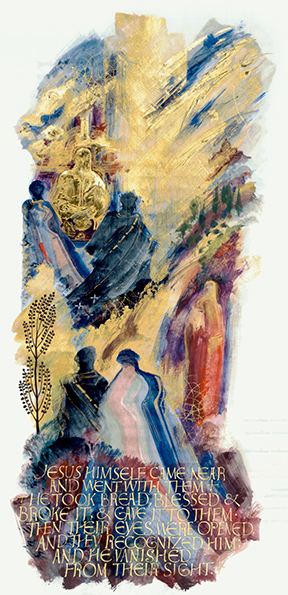Readings: Acts 2:14, 22–33; Psalm 16; 1 Peter 1:17–21; Luke 24:13–35
 Matthew’s gospel records an earthquake preceding the announcement of Jesus’ resurrection—such a fitting symbol for what happened to the disciples—their world was turned upside down; nothing was as it was before. In today’s Gospel, our two dejected disciples also experienced the ground rolling under their feet and the opening of a vast dark empty space which wants to drag them downward.
Matthew’s gospel records an earthquake preceding the announcement of Jesus’ resurrection—such a fitting symbol for what happened to the disciples—their world was turned upside down; nothing was as it was before. In today’s Gospel, our two dejected disciples also experienced the ground rolling under their feet and the opening of a vast dark empty space which wants to drag them downward.
Inexorably being drawn into nothingness, where no-thing made sense, a stranger meets them as they run from the horror of the previous Friday and the confusing and astounding news of Jesus being alive. This stranger, who we know is Jesus, throws them a lifeline grabbing them back from the yawning void by two simple actions. He retells their story and the story of their people from his perspective, shining new meaning on what had happened. And then he performs an action familiar from years of walking with Jesus—taking bread, he blesses, breaks and gives. They knew the risen Lord was with them!
The coronavirus pandemic has been our most recent earthquake—nothing is as it was before! Social distancing and lock downs have removed many of our taken-for-granted activities and a good number of the usual distractions that distance us from thinking about the big questions: What is the meaning of my life? What are my non-negotiable values? —to mention two of the more basic ones.
The two, even after recognizing Jesus, had to deal with the implications of the resurrection. Their familiar terra firma –that death is the last word, the end of life—was just not true. Maybe most of us never felt an earthquake when we heard of the resurrection, but our world has changed because of it. Like the two on the road, we ought to turn to the Risen Jesus accompanying us and seek his guidance as we look toward an unknown future. We have our story that Jesus shared with the two—suffering is an inevitable part of the lot of prophets and new life comes through dying.
The pandemic and our safety measures are giving us precious time to learn about ourselves, our relationships and our world. What we learn is to be prized and stored in a special place in our memory so that when restrictions are lifted, we will not return to the old ways, but create a new normal where the good news of the resurrection and its life-altering vision will be proclaimed.
Today’s art work is from the St. John’s Bible—the first illuminated Bible created in five hundred years. The bible and all its illuminations are invitations to contemplation of mystery. We are encouraged to linger over the images. In the depiction of the story of two on the road to Emmaus we notice gold leaf running through and connecting the two scenes. Gold, in this and all the other illumination, indicate divine presence—the artist’s way of telling us that God is accompanying the disciples and us. Please take some time to dwell in the scene and allow its message to reveal itself.
– Sr. Jean Flannelly, SC
Image: Road to Emmaus, Sally Mae Joseph, Copyright 2002, The Saint John’s Bible, Saint John’s University, Collegeville, Minnesota USA. Used by permission. All rights reserved.
 After more than 35 years preparing men and women for ordained and lay ministry in the Church, Sister Jean currently is engaged in writing projects and ministers in adult spiritual/faith enrichment in Dutchess County.
After more than 35 years preparing men and women for ordained and lay ministry in the Church, Sister Jean currently is engaged in writing projects and ministers in adult spiritual/faith enrichment in Dutchess County.

Thank you, Jean, for your inspirational reflection.